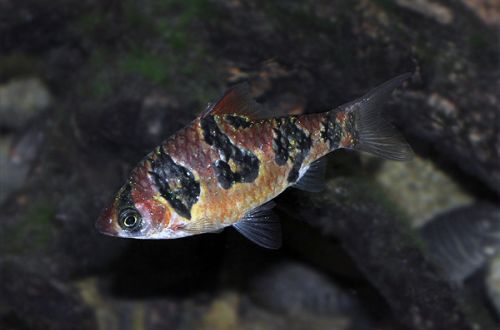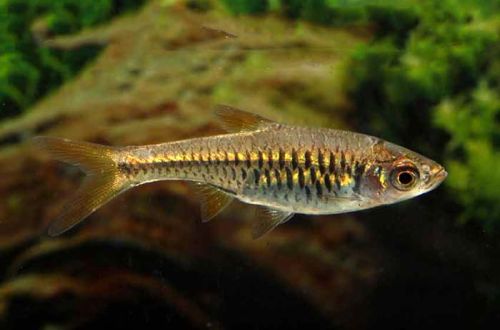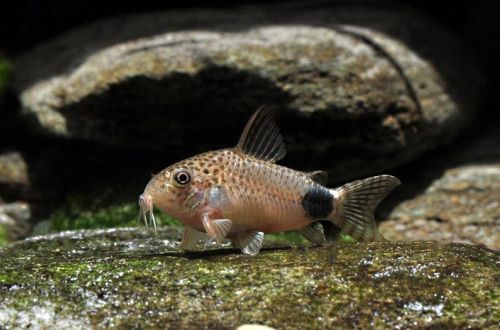
Rhombus barbus
The diamond barb, scientific name Desmopuntius rhomboocellatus, belongs to the Cyprinidae family. A small fish with an original body color, due to the specific requirements for the composition of the water, is used in biotope aquariums that mimic the habitat of the peat bogs of Southeast Asia. Otherwise, it is a very unpretentious species, and if it is possible to create the necessary conditions, then the maintenance of the aquarium will not become a burden.

Contents
Habitat
Endemic to the island of Kalimantan, aka Borneo. Occurs in peat bogs and rivers / streams flowing from them. Prefers to stay in areas with dense aquatic and coastal vegetation. The water in these reservoirs, as a rule, is colored in a rich brown color due to dissolved humic acids and other chemicals that are formed during the decomposition of organic materials (the substrate is littered with fallen leaves, branches) with low mineralization. The hydrogen index fluctuates at around 3.0 or 4.0.
Description
Adult individuals reach a length of about 5 cm, and males are noticeably smaller than females and are distinguished by a more slender body and rich coloration, which is greatly influenced by the level of illumination. Under natural subdued light, the colors are close to pink with a golden coating. Bright light makes the color less elegant, it becomes silvery. In the body pattern there are 3-4 large black marks resembling a rhombus in shape.
Food
In nature, it feeds on small insects, worms, crustaceans and other zooplankton. In a home aquarium, it will accept any dry and freeze-dried food of a suitable size in combination with various frozen and live foods (daphnia, brine shrimp, bloodworms). You can not feed monotonous products, the diet should combine all types. Feed 2-3 times a day in the amount eaten in 5 minutes, all uneaten food residues should be removed to prevent water pollution.
Maintenance and care, arrangement of the aquarium
A flock of diamond-shaped Barbs requires very specific conditions, therefore it is suitable mainly for biotope aquariums. Optimum conditions are achieved in a tank from 80 liters, designed using a soft substrate based on peat and dense thickets of plants located in groups along the side walls. Having additional hiding places in the form of snags, branches and tree roots is welcome, and adding a few pre-dried leaves will give the aquarium a more natural look.
The water parameters have a slightly acidic pH value and a very low level of hardness. When filling the aquarium, a neutral value of the pH value is allowed, which, in the process of maturation of the biosystem, will eventually set itself at the desired level. The filtration system plays an important role here. It is recommended to use filters where peat-based components are used as a filter material. Other equipment consists of low power lighting fixtures, heater and aerator.
Maintenance comes down to a weekly replacement of part of the water with fresh water (15–20% of the volume) and regular cleaning of the soil with a siphon from organic waste.
Behavior and Compatibility
A peaceful, active schooling species, it pairs well with other Southeast Asian cyprinids such as Hengel Rasbora, Espes Rasbora and Harlequin Rasbora. Avoid sharing very noisy large neighbors, they can intimidate the diamond-shaped Barbus.
Keeping in a flock of 8 individuals favorably affects the behavior and color of fish, especially males, since they will have to compete among themselves for the attention of females, and they can do this only by strengthening their own color.
Breeding / breeding
Like most small cyprinids, barbs are able to spawn in a community aquarium without recreating special conditions. They do not show parental care, therefore they are able to eat their own offspring. A number of fry can survive and survive to adulthood without any intervention from the aquarist, but this number can be greatly increased by spawning in a separate tank.
The spawning aquarium is a small tank with a volume of 30-40 liters, filled with water from the main aquarium. A simple sponge filter and a heater are installed from the equipment. Installation of lighting is not required, the light coming from the room is quite enough. In the design, you can use shade-loving plants, aquatic ferns and mosses. The main attention should be paid to the substrate, it should consist of balls with a diameter of about 1 cm or from ordinary soil, but covered with a fine mesh on top. When the eggs roll into the space between the balls or fall under the net, they become inaccessible to the parents, which helps protect them from being eaten.
Spawning at home is not tied to any specific time. Always keep an eye on the fish and if you notice that some of them are noticeably rounded, then you should expect an addition soon. The females and the selected male – the most beautiful and largest – are placed in a spawning aquarium, everything should happen soon. When delaying the process, do not forget to feed your pets and promptly remove waste products and uneaten food remnants.
Fry from caviar appear after 24-36 hours, however, they begin to swim freely only on the 3-4th day, from this moment you should start serving specialized microfeed, which is supplied to most pet stores.





